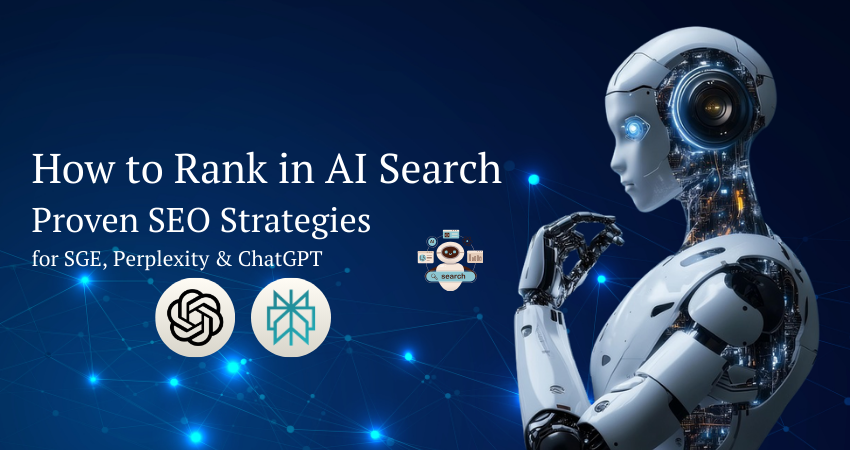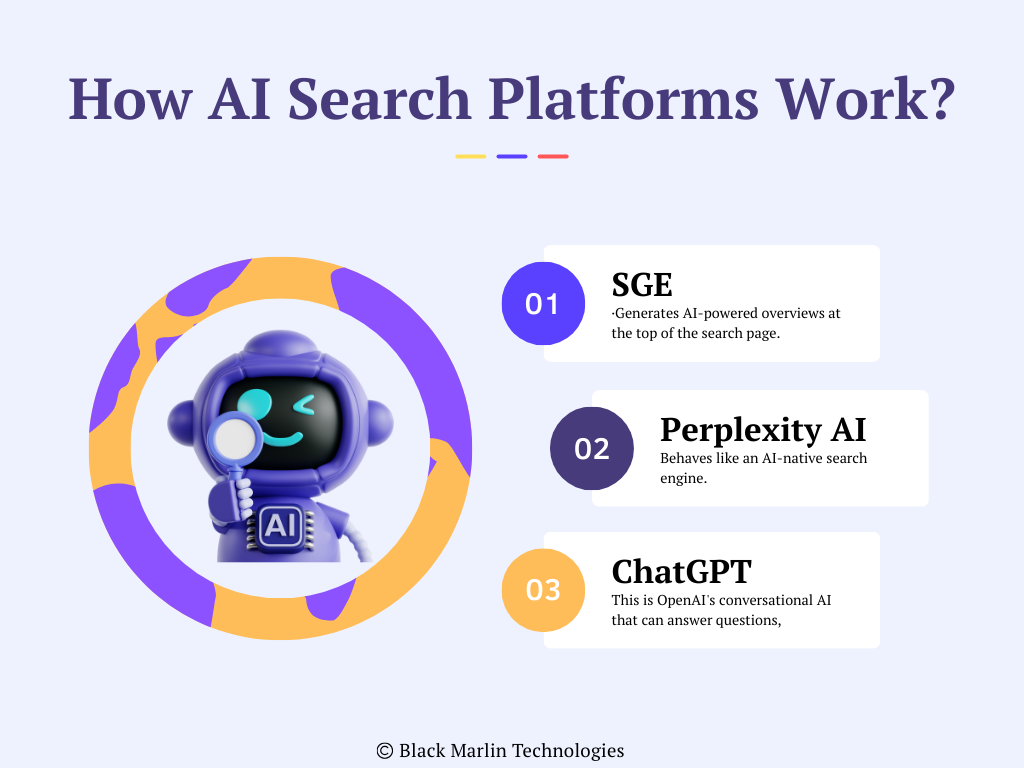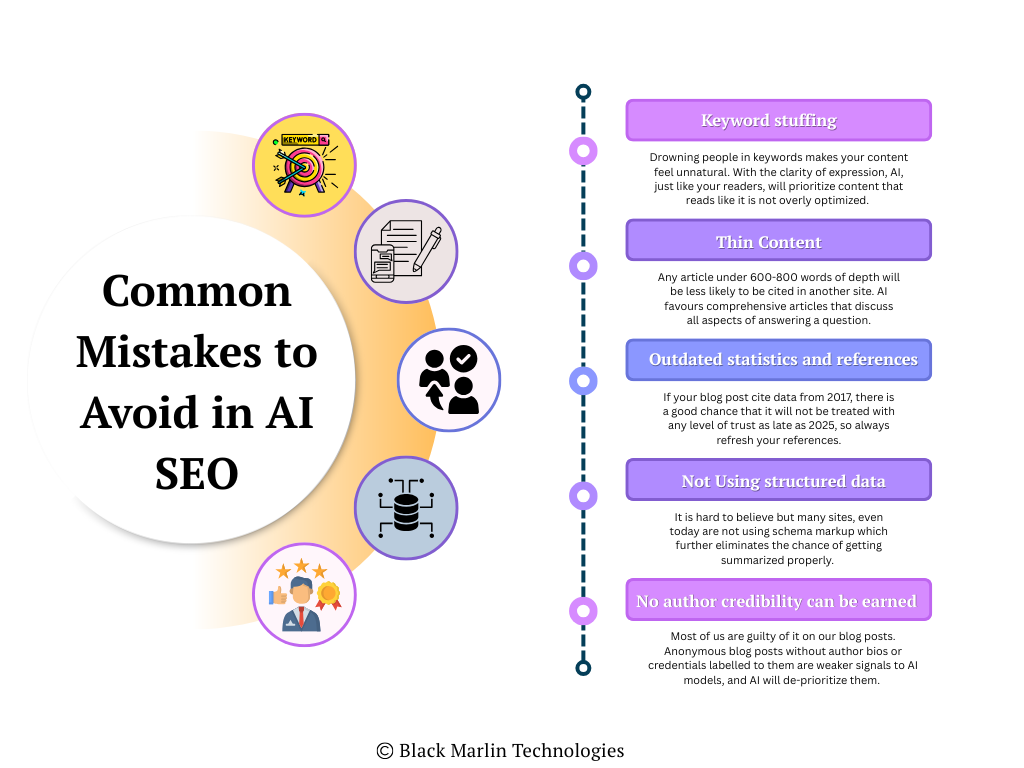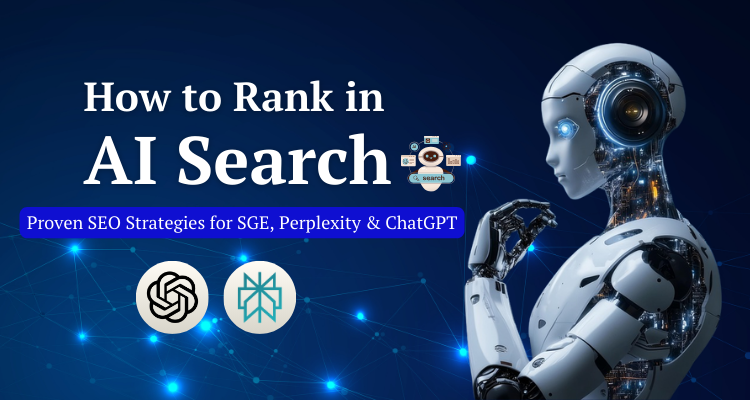Searching, surfing, researching, or whatever we call it, is definitely not what it used to be. The days of slapping some keywords into Google and spending hours mindlessly scrolling blue links are long gone. Even the concept of searching, finding and trusting information has shifted in the age of Artificial Intelligence. With Google’s Search Generative Experience (SGE) now being voiced to plenty of users and the new technology and companies like Perplexity and ChatGPT creating a world where searching is conversational, contextualized, and answer driven.

This has created both challenges and opportunities for brands. Brands need to understand how AI-driven search engines work, and how to get cited, referenced, and recommended by them. Uses of traditional search engine optimization, like keyword density, backlinks, and meta tags, has changed and is no longer enough, as individual tactics.
In this blog post, we’re going to discuss how to position for ranking in an AI search results world. We will talk about how traditional (or conventional) search is different from AI search, why ranking matters in AI search results, and what proven and tested SEO tactics you can use to thrive in AI search engines like SGE, Perplexity, and ChatGPT:
The Evolution of Search: From Keywords to Conversations
Over the past few decades, SEO has primarily been focused on Google’s algorithm. A simple logic existed, optimize for keywords, build links, optimize for technical. AI-oriented search platforms present both new possibilities compared to static ranking signals. Here are some notable changes:
- From keywords to intent: Users no longer type linear keyword strings like, “best running shoes 2025 reviews.” Users will ask natural questions, “What are the best running shoes for flat feet this year, and which are the cheapest?”
- From results to answers: Instead of listing out ten blue links, AI tools are producing full answers sometimes with context and supporting resources.
- From single prompts to dialog: Users are able to inquire follow-up questions and AI are able to retain context, making search more of a conversation than a simple transaction.
- From static rank to real-time synthesis: With some tools such as Perplexity and others, it could cite a dozen sources on the fly to synthesize them into an understandable answer.
This means that your content needs to be both discoverable and presentable for summarization, citation, and reputed as authoritative.
This means your content must be discoverable, and also presentable for summarization, citation, and considered authoritative.
Why Ranking in AI Search Matters
Some marketers believe AI-rendered answers will eliminate the need for SEO. The reality is the opposite: we have never needed SEO more. Here are some reasons why:
- AI search is now ubiquitous: within just a few moments, millions of users have already begun using Perplexity, ChatGPT and SGE for daily question asking, and this audience will grow for the foreseeable future as AI adds further features to browsing, operating systems, and devices.
- Yes AI clicks are down, but trust is up: AI does answer questions on page (fewer clicks), but if your brand is named in the AI answer, you do become a trusted voice of authority to thousands of users.
- Brands are competing for evidence: While there are still a vast number of companies making economic decisions from old-school SEO, those that shift now, will lead AI search in citations.
- It defines brands: being named in AI tools is high-value proposition, users will trust you as an authority brand. Once Perplexity (for example) references your site 50 times, you have won trust now.
In summary, if you want to be a part of the search landscape changing before us, ranking in AI search is not optional.
How AI Search Platforms Work?
To leverage properly, you will have to be aware of how each powered AI system operates.

1. Google Search Generative Experience (SGE)
This is the Google’s AI powered search that gives abbreviated answers and insights directly in search results, and valued for being able to find legit information on the fast.
- Generates AI-powered overviews at the top of the search page.
- Pulls from multiple authoritative sources and incorporates structured data.
- Still experimental, but gradually rolling into the market fast in 2025.
- Rewards E-E-A-T (Experience, Expertise, Authoritativeness, Trustworthiness), and “fresh” content.
2. Perplexity AI
This is a AI powered search and answer engine that provides an instant and accurate answer with sources quickly and reliably for the user to consider exploring topics.
- Behaves like an AI-native search engine.
- Gives answers with direct citations from multiple sources.
- Very favorable when engaging simplistically, credibility and structure.
- Functions almost as a real-time research assistant.
3. ChatGPT (with browsing)
This is OpenAI’s conversational AI that can answer questions, generate content and write live-browse to give up-to-date, accurate information beyond its training.
- Answers questions through conversations.
- With browsing enabled, it pulls and summarizes items in real-time.
- Cites fewer sources than Perplexity but passes through plugins.
- Optimized by producing well-structured, longform, educational content.
Each rewards slightly different strategies, however, all appreciated depth of information, clarity, authority and structure.
Proven SEO Strategies to Rank in AI Search
Let’s go over the actionable, step-by-step items you can do today.
1. Optimize for conversational queries – optimizing for conversational queries means that you organize your content in a manner that answers questions how humans would ask them in actual life. This includes long-tail, question-based, and dialogue-style phrases and does not only focus on exact match short key-phrases. This is important, because AI Search Engines like SGE, Perplexity and ChatGPT are using training based on natural language, not just keyword strings.
- Use only long-tail natural sounding key-phrases.
- Use headings that match how people ask questions. (ex: “What is SGE in Google Search?”).
- Use FAQ sections with Q&A structure.
- Think of the follow up questions that the readers might have, and include them in you content.
Here is an example: instead of calling your blog “AI SEO Tips”, you can say “How to Rank in AI Search Engines Like: SGE, Perplexity & ChatGPT.”
2. Employ Structured Data and Schema Markup – Structured data is a standardized method to present information about a page and categorize its content. Schema markup (a vocabulary derived from Schema.org) is the code you put on your website to help search engines better understand not just what your content says, but what it means.
Structured data can be processed by Artificial Intelligence systems better than unstructured text. Use:
- FAQ Schema if you have Q&A.
- How To Schema if you have a tutorial.
- Article Schema with author bios and date published.
Google has a Structured Data Guide which is a good resource for learning how to implement these SEO strategies.
3. Understand the Importance of Experience – Expertise – Authoritativeness – Trustworthiness or E-E-A-T. It is a concept that Google originally used in its Search Quality Rater Guidelines – the reason it is being mentioned again is that the same concepts are being applied when dealing with AI Search Models because they use credibility signals to create responses. The content we create that optimally gets searched and surfaced using AI does not use keyword matching like the example above, it actually uses ranking based on the signal of E-E-A-T. Google, and other AI models like ChatGPT, SGE, and Perplexity, are finding this concept very valuable when trying to determine what content gets to be searched, and trusted.
- Add rich biographies of authors qualifications.
- Use credible sources (e.g., academic journals, .gov sites, or commercial publishers).
- Show original research, surveys or case studies.
- Be on authoritative sources or cited by authoritative sources.
E-E-A-T not only applies to Google, but Perplexity and ChatGPT are going to show preference to authoritative voices as well.
4. Create In-Depth, Clear and Comprehensive Content – In-depth, clear and comprehensive content means that the topic is covered relaxed and thoroughly, the information is processed in a way that is easy to consume, and the full user intent is addressed. It ensures that when a person is done reading (or AI is pulling from your content), that there are no outstanding large questions remaining. Search engines (and AI companies) care about one thing: delivering the most useful, accurate, and satisfying answer to a user’s question. In a competitive landscape, to be unique you should provide ALL information that is NOT surface-level. They must be as deep and complete, have clarity, and encompass the full user intent.
- Consider long-form guides 2000+ words, which is totally appropriate for covering a topic sedately.
- Break up content into smaller chunks that are easy to consume with bullet points and sub-headings
- Consumption of your content does not need to end – Summaries are a great way to consume information at the end of content sections, as are key takeaways.
AI-based systems and others are typically more likely to cite content that contain fully-formed clear answers in one place.
5. Optimize for Featured Snippets and Zero-Click Searches – Featured snippets are clipped, short answers that are presented on the top of the search results page in varying formats examples are paragraph, lists, tables, and video. Zero-click searches are when Internet users are finding the relevant information in these snippets (or through an AI search assistant) and they don’t land on the source site. Our search behaviour is evolving and digital users are gaining answers from snippets or AI directly on the search page, without clicking and navigating to a website. This is referred to as zero-click search, and it is associated with featured snippets (the highlighted box that Google displays at the top of search results).
There are many artificial intelligence systems that are connected to the same sites or that produce content based on often used featured snippets.
- Provide succinct answers to questions at the top of sections.
- Subscribe to lists, tables, and bullet points.
- Define terms in your content directly.
Example:
What is Perplexity AI?
Perplexity AI is a conversational search engine that produces a relevant real time answer using artificial intelligence, with citations in its responses.
6. Refresh and Update Content Regularly – Stale content is quickly devalued in the fast-moving digital landscape; both for users, and AI search engines. While some content may have been accurate or relevant just two years ago, the content is very likely obsolete. AI tools used by search engines, such as Google SGE, Perplexity, and ChatGPT regularly recycle search results by putting fresh information first. You can refresh and update existing articles, pages, and blogs to add fresh new content or new information, statistics or case studies and take your website even further. By refreshing your blog, it does not mean you need to redevelop everything from scratch, just ensure your content is accurate, meaningful, and relevant to the present.
AI platforms promote fresh, dependable content.
- Use “2025 Edition”, for existing articles.
- Use new statistics, case studies, or examples.
- Expand old posts every 6 months and adjust/build upon the obsolete aspects.
7. Optimize for Multi-Modal Search – Nowadays users can discover content through text, voice, images, and even video. Multi-modal search refers to the ability for search engines and AI search abilities to handle results in formats other than text; for example, you may now receive not just written articles, but results that include images, videos, infographics, or audio content. Optimizing for this means making sure all of your content is discoverable, usable, and understood through all of these formats.
AI search is no longer in a purely textual space. So, include:
- Relevantly placed images with descriptive alt text.
- Condensed explainer videos embedded in the article.
- Infographics that summarize hard-to-understand data.
This leads to more use of your content and something which can be referenced by AI.
8. Generate Citations around the Web – Visibility in the world of AI-based search is not only about ranking on your site. Most of the AI platforms will scour the web for the sources that have been referenced and cited the most and that have the most brand trust. Citations will help you to do that. Building citations around the web is like getting your brand, business, or content mentioned and referenced as much as possible on sites for authority, directories, and news and niche sites. Citations do not always require a clickable link like traditional backlinks do; just a mention of your brand as plain text can also show AI models credibility.
Moreover, some AI tools like Perplexity reward based on the extent of references. Here are a few things you can do:
- Post on Medium, LinkedIn, and guest blog posts.
- Spread your research or press releases.
- Ask journalists to link to your content and to niche blogs.
9. Enforce Technical SEO – While content quality and authority get the lion’s share of attention in conversations around SEO, technical SEO is the base upon which the rest rests, and it helps you create a website that search engines have access to, can crawl quickly, and can serve to humans quickly and easily. Without technical SEO, even the best articles and content can struggle to be found and cited in results from Google SGE, Perplexity, ChatGPT, and the like. Generally speaking, technical SEO involves the backend tweaks and structural changes you make to your website to make it easier for search engines – any search engine – to crawl, index, and provide a good experience for a person. This includes increasing the speed, security, compatibility with mobile devices, and architecture and structure of the whole site. These properties influence the ways in which search engines (and newly – AI systems) assess and represent hypotheses and information.
User experience counts. So, be sure to:
- Keep fast page loading speed (check with PageSpeed Insights).
- Use mobile-first responsive design.
- Serve content securely with HTTPS.
- Use a clean site architecture and internal linking.
10. Utilize User-Generated Content and Communities – User-generated content is any kind of content that is created by or contributed to by customers, audiences, or community members which might take the form of reviews, testimonials, forum conversations and exchanges, Q&A threads, social media posts and so on, even case studies. Using communities means creating communities such as online forums, groups, or interactive spaces for users to share their experiences and to talk about and contribute knowledge.
As search engines powered by artificial intelligence prioritize authenticity and trust as the primary criteria for how they evaluate information, the assets of user-generated content (UGC) and online communities are some of the most valuable components of a brand’s marketing strategy. Search engines like Google SGE, Perplexity, and ChatGPT do not only pull information from perfected brand copy, they pull information from insights, reviews, and discussions from actual users on the web.
- Authenticity is extremely valuable in AI search engines. Therefore make sure to:
- Gather customer reviews and testimonials.
- Host your community Q&A forums.
- Publish video interviews or stories from actual users.
The more diverse and authentic your content is, the more AI engines will trust and cite it.
Practical Implementation Framework
To make this actionable, here is a step-by-step framework:
1. Keyword & Query Research
- Use tools like AnswerThePublic or SEMrush to find conversational queries.
2. Content Creation
- Develop pillar pages (long, comprehensive guides) and cluster content (shorter supporting articles).
- Include FAQs and multimedia elements.
3. Schema & Technical SEO
- Implement schema markup for FAQs, How Tos, and Articles.
- Audit site speed and mobile usability.
4. Authority Building
- Guest post, get media coverage, and pursue backlinks.
- Publish original data and research.
5. Monitoring & Optimization
- Track performance with Google Search Console and Ahrefs.
- Monitor AI-driven traffic and citations from Perplexity or ChatGPT (by testing queries yourself).
- Update content quarterly.
The Future of SEO in the AI Era
Coming into the future, there are a few significant trends that will help shape how we optimize for an AI search experience.
- Voice + AI Search: Voice assistants have adopted generative AI. This means that queries will be more conversational.
- Personalized Results: AI will factor in users’ search history and preferences to deliver personalized results.
- Rise of Niche Authority: A smaller site that specializes in niche expertise can compete alongside huge sites in the digital landscape.
- Integration with Commerce: If AI can deliver an answer it can also recommend, compare, even help you complete a purchase
Companies that adapt early will not just survive, they will THRIVE!
Case Studies: Brands Winning in AI Search
Sometimes, the best way to understand a strategy is to see it with your own eyes in action. Let’s now see how various organizations are already adapting to the reality of AI-enhanced search.
Example 1: A Tech Blog in SGE
A mid-sized tech blog that specializes in smartphone reviews saw a hit to organic clicks in 2024 after the introduction of SGE by Google. Rather than panic, the team optimized all their product reviews by:
- FAQ sections that attempted to answer buyers questions they typically have (“Is the iPhone 16 better than Samsung S25?).
- Comparison tables with structured data.
- Author bio about the author that discussed their years of expertise.
Six months later, they noticed that they were beginning to show up in AI summaries for phrases like “best smartphones for photography 2025”. After adopting AI-only SEO practices, their referral traffic from Perplexity increased by 67% and their newsletter sign-up conversions have doubled. This is a clear indication that their visibility and engagement are trending in a positive direction despite changing user behaviour.
Example 2: A Health Website in Perplexity
A health and wellness site that focused on Nutrition updated its articles and references several peer-reviewed journals in a thoughtful and clear process. Perplexity AI used their content all the time because they had concise answers that were medically referenced and incorporated the benefits of website schema.
This site was consistently cited enough that secondary discovery traffic became overwhelmingly driving traffic (they found it through some search before seeing the brand in Perplexity). The trust citations turned into long-term users.
Example #3: Finance blog with ChatGPT
A finance blogger built their content around education, and produced long form guides such as “How to Build a Retirement Portfolio in 2025.” Because ChatGPT tends to synthesize answers from long-form guides, the blog’s content had become a go-to reference. The writer also dabbled in publishing some summaries on LinkedIn and Medium to create more citations.
The result: ChatGPT tended to summarize parts of the guide whenever a user asked about retirement strategies, which also gave relevance back to this blogger’s site.
Common Mistakes to Avoid in AI SEO
Just as there are winning strategies, there are also pitfalls making your content invisible to AI search systems. Here are some of the most common pitfalls:

- Keyword stuffing – Drowning people in keywords makes your content feel unnatural. With the clarity of expression, AI, just like your readers, will prioritize content that reads like it is not overly optimized.
- Thin Content – Any article under 600-800 words of depth will be less likely to be cited in another site. AI favours comprehensive articles that discuss all aspects of answering a question.
- Outdated statistics and references – If your blog post cite data from 2017, there is a good chance that it will not be treated with any level of trust as late as 2025, so always refresh your references.
- Not Using structured data – It is hard to believe but many sites, even today are not using schema markup which further eliminates the chance of getting summarized properly.
- No author credibility can be earned – Most of us are guilty of it on our blog posts. Anonymous blog posts without author bios or credentials labelled to them are weaker signals to AI models, and AI will de-prioritize them. AI models are looking for signals of credibility and expertise.
Expanding Your Content Beyond the Blog
AI search engines are no longer limited to just traditional blog posts. In order to increase your possibilities of being cited you can do the following:
- Podcasts and Transcripts: Post podcast episodes with transcripts. AI tools can read transcripts like blog posts.
- YouTube Videos: Optimize titles, descriptions and closed captions. Sometimes Google SGE pulls video snippets.
- Slide Decks and Whitepapers: Post thought-leadership content on SlideShare or your website.
- Infographics: Visually summarize key findings, AI works with infographics and can read it and reference it if the descriptive alt text is embedded.
By expanding the content formats you use takes advantage of different ways of getting cited in AI-powered search systems.
Deep Dive: The Role of Backlinks in AI SEO
While backlinks still matter, AI engines treat them differently than Google’s early days. They’re far less interested in quantities, preferring to assess:
- Contextual Relevance: Is the backlink from a source that is topically related to your content?
- Diversity of References: More references by separate domains suggest credibility at a larger scale.
- Citation Momentum: AI engines will assess how much your content is being referenced across platforms, not just in links, but unlinked mentions also.
For example, if a renowned tech journalist references your research in an article and does not link to you, when Perplexity assembles its answer it might view this as a credibility indicator.
AI SEO Checklist for 2025
To make everything actionable, here is an actionable checklist that you can check-off.
- Does your content answer conversational queries directly?
- Are you using FAQ, How To, and Article Schema?
- Are your author bios robust, with expertise and credentials?
- Is your content 1,500+ words, and thorough?
- Are you updating your content every quarter with new data?
- Are you utilizing images, videos, and infographics?
- Are you creating content outside of blogging (podcasts, LinkedIn, etc.)?
- Are you acquiring credible backlinks and mentions around the web?
If you can check off most of these checklist items, you’re well on your way to being visible in AI search systems.
Looking Further Ahead: Predictions for 2026 and Beyond
Although 2025 is when AI search going mainstream, here is a snapshot of what not-so-far-off developments could look like:
- Real-Time Personalization: AI engines might even tailor their answers specifically for you based on your browsing history, preferences, and even purchasing behavior.
- Commerce Integration: Queries such as “What’s the best laptop under Rs.25,000” should show AI curated options for buying right away.
- Increased Regulation: Governments might encourage the disclosure of AI citation to sidestep misinformation.
- Decentralized Content Verification: Verification of authorship based on blockchain forms could become important for authorship validation.
- AI-to-AI SEO: As people begin to use personal AI agents that will consult other AI engines, you will have to think about optimizing for not only people requesting your content but how the AI interprets and negotiates with other AI.
Key Takeaways
- AI search means answers, not rankings.
- Focus on conversational questions and FAQ style content.
- Use structured data to get AI to understand your content.
- Build trust through E-E-A-T principles.
- Keep content long, clear and updated regularly.
- Be cited as a source on other platforms to create AI visibility.
Final Thoughts
SEO is no longer about manipulating algorithms with specific keywords, links and key search patterns; it is now about building authoritative, useful, and trustworthy content that AI applications can summarize, cite and recommend. Ranking in AI search is not a rejection of SEO practice, however; it is a progressive when it comes to SEO. SEO will transform from keyword-based tactics to a priority of authority, clarity and context.
Google’s SGE, Perplexity, ChatGPT and applications like these are not the end of SEO; they are an evolution of it. By focusing on conversational optimization, structured data, and authority-based content strategies at the business and brand level, you will develop methods for being ‘front of mind.’
As a small business, this is great news for you: you do not need millions of backlinks to compete. You just need good, authoritativeness and updated content that answers real human based questions.
If you are an enterprise brand, the opportunity is even larger: by aligning your digital assets with AI-friendly practices, you can win visibility on four or five AI platforms at once.
Those that take the stance that AI is not a threat, but a new distribution channel, and that this distribution channel rewards what users have always wanted – accuracy, expertise and trust, will succeed in this new phase.
The businesses that shift now will be the brands that AI references tomorrow. The end of SEO as we know it is not about whom ranks #1 but rather it is about being the answer.
 +1-(646) 362-1414
+1-(646) 362-1414 +91 8826683820
+91 8826683820



